New Materials Based on Molecular Interaction between Hyaluronic Acid and Bovine Albumin
Abstract
:1. Introduction
2. Results
2.1. FTIR
2.2. Mechanical Properties
2.3. AFM
2.4. Molecular Docking
3. Discussion
4. Materials and Methods
4.1. Materials
4.2. Preparation of Solutions
4.3. Preparation of Polymer Mixtures and Films
4.4. FTIR Spectroscopy
4.5. Mechanical Properties
4.6. AFM
4.7. Molecular Docking
5. Conclusions
Supplementary Materials
Author Contributions
Funding
Institutional Review Board Statement
Informed Consent Statement
Data Availability Statement
Conflicts of Interest
Sample Availability
References
- Francis, R.; Sasikumar, S.; Gopalan, G.P. Synthesis, Structure, and Properties of Biopolymers (Natural and Synthetic). In Polymer Composites; Wiley Online Library: Hoboken, NJ, USA, 2013; pp. 11–107. [Google Scholar]
- Sionkowska, A. The potential of polymers from natural sources as components of the blends for biomedical and cosmetic applications. Pure Appl. Chem. 2015, 87, 1075–1084. [Google Scholar] [CrossRef]
- Roopan, S.M.; Surendra, T.V.; Madhumitha, G. Preparation and Properties of Biopolymers: A Critical Review. In Handbook of Polymers for Pharmaceutical Technology; Wiley Online Library: Hoboken, NJ, USA, 2015; Volume 3, pp. 541–555. [Google Scholar]
- Ashish, G.; Sanjay, M.R.; Srisuk, R.; Parameswaranpillai, J.; Siengchin, S. A comprehensive review on chemical properties and applications of biopolymers and their composites. Int. J. Biol. Macromol. 2020, 154, 329–338. [Google Scholar]
- Jurak, M.; Wiącek, A.E.; Ładniak, A.; Przykaza, K.; Szafran, K. What affects the biocompatibility of polymers? Adv. Colloid Interface Sci. 2021, 294, 102451. [Google Scholar] [CrossRef] [PubMed]
- Xia, G.-X.; Wu, Y.-M.; Bi, Y.-F.; Chen, K.; Zhang, W.-W.; Liu, S.-Q.; Zhang, W.-J.; Liu, R.-H. Antimicrobial Properties and Application of Polysaccharides and Their Derivatives. Chin. J. Polym. Sci. 2021, 39, 133–146. [Google Scholar] [CrossRef]
- Bealer, E.J.; Kavetsky, K.; Dutko, S.; Lofland, S.; Hu, X. Protein and Polysaccharide-Based Magnetic Composite Materials for Medical Applications. Int. J. Mol. Sci. 2020, 21, 186. [Google Scholar] [CrossRef] [Green Version]
- Amandusova, A.K.; Saveleva, K.R.; Morozov, A.V.; Shelekhova, V.A.; Persanova, L.V.; Polyakov, S.V.; Shestakov, V.N. Physical and Chemical Properties and Quality Control Methods of Hyaluronic Acid (Review). Drug Dev. Regist. 2020, 9, 136–140. [Google Scholar] [CrossRef]
- Snetkov, P.; Zakharova, K.; Morozkina, S.; Olekhnovich, R.; Uspenskaya, M. Hyaluronic Acid: The Influence of Molecular Weight on Structural, Physical, Physico-Chemical, and Degradable Properties of Biopolymer. Polymers 2020, 12, 1800. [Google Scholar] [CrossRef]
- Sionkowska, A.; Gadomska Musiał, K.; Piątek, J. Hyaluronic Acid as a Component of Natural Polymer Blends for Biomedical Applications: A Review. Molecules 2020, 25, 4035. [Google Scholar] [CrossRef]
- Dong, X.; Zhang, Y.Q. An insight on egg white: From most common functional food to biomaterial application. J. Biomed. Mater. Res. 2021, 109, 1045–1058. [Google Scholar] [CrossRef]
- Gadomska, M.; Sionkowska, A.; Musial, K. New Materials Based on Hyaluronic Acid and Egg Albumin Mixture. Eng. Biomater. 2021, 160, 15–21. [Google Scholar]
- Arabi, S.H.; Haselberger, D.; Hinderberger, D. The Effect of Ethanol on Gelation, Nanoscopic, and Macroscopic Properties of Serum Albumin Hydrogels. Molecules 2020, 25, 1927. [Google Scholar] [CrossRef] [Green Version]
- Lantigua, D.; Nguyen, M.A.; Wu, X.; Suvarnapathaki, S.; Kwon, S.; Gavinc, W.; Camci-Unal, G. Synthesis and characterization of photocrosslinkable albumin-based hydrogels for biomedical applications. Soft Matter 2020, 16, 9242–9252. [Google Scholar] [CrossRef]
- Xia, T.; Jiang, X.; Deng, L.; Yang, M.; Chen, X. Albumin-based dynamic double cross-linked hydrogel with self-healing property for antimicrobial application. Colloids Surf. B Biointerfaces 2021, 208, 112042. [Google Scholar] [CrossRef]
- Maciążek-Jurczyk, M.; Szkudlarek, A.; Chudzik, M.; Pożycka, J.; Sułkowska, A. Alteration of human serum albumin binding properties induced by modifications: A review. Spectrochim. Acta Part A Mol. Biomol. Spectrosc. 2018, 188, 675–683. [Google Scholar] [CrossRef]
- Chen, Z.; Chen, J.; Wu, L.; Li, W.; Chen, J.; Cheng, H.; Pan, J.; Cai, B. Hyaluronic acid-coated bovine serum albumin nanoparticles loaded with brucine as selective nanovectors for intra-articular injection. Int. J. Nanomed. 2013, 8, 3843–3853. [Google Scholar] [CrossRef] [Green Version]
- Beldowski, P.; Przybylek, M.; Raczynski, P.; Dedinate, A.; Gorny, K.; Wieland, F.; Dendzik, Z.; Sionkowska, A.; Claesson, M.P. Albumin-Hyaluronan Interactions: Influence of Ionic Composition Probed by Molecular Dynamics. Int. J. Mol. Sci. 2021, 22, 12360. [Google Scholar] [CrossRef]
- Ghomi, E.R.; Nourbakhsh, N.; Kenari, M.A.; Zare, M.; Ramakrishna, S. Collagen-based biomaterials for biomedical applications. J. Biomed. Mater. Res. 2021, 109, 1986–1999. [Google Scholar] [CrossRef]
- Tyan, Y.C.; Yang, M.H.; Chang, C.C.; Chung, T.W. Biocompatibility of Materials for Biomedical Engineering. Adv. Exp. Med. Biol. Book Ser. 2020, 1250, 125–140. [Google Scholar]
- Sionkowska, A. Current research on the blends of natural and synthetic polymers: Review. Prog. Polym. Sci. 2011, 36, 1254–1276. [Google Scholar] [CrossRef]
- Werkmeister, J.A.; Edwards, G.A.; Casagranda, F.; White, J.F.; Ramshaw, J.A.M. Evaluation of a collagen-based biosynthetic materials for the repair of abdominal wall defects. J. Biomed. Mater. Res. 1998, 39, 429–436. [Google Scholar] [CrossRef]
- Muthuraj, R.; Misra, M.; Mohanty, A.K. Biodegradable compatibilized polymer blends for packaging applications: A literature review. J. Appl. Polym. Sci. 2018, 135, 45726. [Google Scholar] [CrossRef] [Green Version]
- Younas, M.; Noreen, A.; Sharif, A.; Majeed, A.; Hassan, A.; Tabasum, S.; Mohammadi, A.; Zia, K.M. A review on versatile applications of blends and composites of CNC with natural and synthetic polymers with mathematical modelling. Int. J. Biol. Macromol. 2019, 124, 591–626. [Google Scholar] [CrossRef] [PubMed]
- Tabasum, S.; Younas, M.; Zaeem, M.A.; Majeed, I.; Majeed, M.; Noreen, A.; Iqbal, M.N.; Zia, K.M. A review on blending of corn starch with natural and synthetic polymers, and inorganic nanoparticles with mathematical modelling. Int. J. Biol. Macromol. 2019, 122, 969–996. [Google Scholar] [CrossRef] [PubMed]
- Tabasum, S.; Noreen, A.; Maqsood, M.F.; Umar, H.; Akram, N.; Nazli, Z.I.H.; Chatha, S.A.S.; Zia, K.M. A review on versatile applications of blends and composites of pullulan with natural and synthetic polymers. Int. J. Biol. Macromol. 2018, 120, 603–632. [Google Scholar] [CrossRef] [PubMed]
- Heidenreich, A.C.; Perez-Recalde, M.; Wusener, A.G.; Hermida, E.B. Collagen and chitosan blends for 3D bioprinting: A rheological and printability approach. Polym. Test. 2020, 82, 106297. [Google Scholar] [CrossRef]
- Hu, X.; Ricci, S.; Naranjo, S.; Hill, Z.; Gawason, Z. Protein and Polysaccharide-Based Electroactive and Conductive Materials for Biomedical Applications. Molecules 2021, 26, 4499. [Google Scholar] [CrossRef] [PubMed]
- Luo, M.; Zhang, X.; Wu, J.; Zhao, J. Modifications of polysaccharide-based biomaterials under structure-property relationship for biomedical applications. Carbohydr. Polym. 2011, 266, 118097. [Google Scholar] [CrossRef] [PubMed]
- Kalirajan, C.; Dukle, A.; Nathanael, A.J.; Oh, T.; Manivasagam, G. A Critical Review on Polymeric Biomaterials for Biomedical Applications. Polymers 2021, 13, 3015. [Google Scholar] [CrossRef]
- Hemshekhar, M.; Thushara, R.M.; Chandranayaka, S.; Sherman, L.S.; Kemparaju, K.; Girish, K.S. Emerging roles of hyaluronic acid bioscaffolds in tissue engineering and regenerative medicine. Int. J. Biol. Macromol. 2016, 86, 917–928. [Google Scholar] [CrossRef]
- Taguchi, T.; Tanaka, J. Swelling behavior of hyaluronic acid and type II collagen hydrogels prepared by using conventional crosslinking and subsequent additional polymer interactions. J. Biomater. Sci. Polym. Ed. 2002, 13, 43–52. [Google Scholar] [CrossRef]
- Taguchi, T.; Ikoma, T.; Tanaka, J. An improved method to prepare hyaluronic acid and type II collagen composite matrices. J. Biomed. Mater. Res. 2002, 61, 330–336. [Google Scholar] [CrossRef]
- Chung, E.J.; Jakus, A.E.; Shah, R.N. In situ forming collagen-hyaluronic acid membrane structures: Mechanism of self-assembly and applications in regenerative medicine. Acta Biomater. 2013, 9, 5153–5161. [Google Scholar] [CrossRef]
- Lee, S.J.; Kim, S.Y.; Lee, Y.M. Preparation of porous collagen/hyaluronic acid hybrid scaffolds for biomimetic functionalization through biochemical binding affinity. J. Biomed. Mater. Res. B Appl. Biomater. 2007, 82B, 506–518. [Google Scholar] [CrossRef]
- Liu, Y.; Fan, D. Novel hyaluronic acid-tyrosine/collagen-based injectable hydrogels as soft filler for tissue engineering. Int. J. Biol. Macromol. 2019, 141, 700–712. [Google Scholar] [CrossRef]
- Ying, H.Y.; Zhou, J.; Wang, M.Y.; Su, D.D.; Ma, Q.Q.; Lv, G.Z.; Chen, J.H. In situ formed collagen-hyaluronic acid hydrogel as biomimetic dressing for promoting spontaneous wound healing. Mater. Sci. Eng. C Mater. Biol. Appl. 2019, 101, 487–498. [Google Scholar] [CrossRef]
- Kim, S.; Cho, D.H.; Kweon, D.K.; Jang, E.H.; Hong, J.Y.; Lim, S.T. Improvement of mechanical properties of orodispersible hyaluronic acid film by carboxymethyl cellulose addition. Food Sci. Biotechnol. 2020, 29, 1233–1239. [Google Scholar] [CrossRef]
- Ghorbani, F.; Zamanian, A.; Behnamghader, A.; Behnamghader, A.; Joupari, M.D. Bioactive and biostable hyaluronic acid-pullulan dermal hydrogels incorporated with biomimetic hydroxyapatite spheres. Mat. Sci. Eng. C Mater. 2020, 112, 110906. [Google Scholar] [CrossRef]
- Guan, Y.; You, H.; Cai, J.; Zhang, Q.; Yan, S.Q.; You, R.C. Physically crosslinked silk fibroin/hyaluronic acid scaffolds. Carbohyd. Polym. 2020, 239, 116232. [Google Scholar] [CrossRef]
- Antich, C.; de Vicente, J.; Jimenez, G.; Chocarro, C.; Carrillo, E.; Montanez, E.; Galvez-Martin, P.; Marchal, J.A. Bio-inspired hydrogel composed of hyaluronic acid and alginate as a potential bioink for 3D bioprinting of articular cartilage engineering constructs. ACTA Biomater. 2020, 106, 114–123. [Google Scholar] [CrossRef]
- Andrysiak, T.; Bełdowski, P.; Sidodmiak, J.; Weber, P.; Ledzinski, D. Hyaluronan-chondroitin sulfate anomalous crosslinking due to temperature changes. Polymers 2018, 10, 560. [Google Scholar] [CrossRef] [Green Version]
- Dėdinaitė, A.; Wieland, D.C.F.; Beldowski, P.; Claesson, P.M. Biolubrication synergy: Hyaluronan–Phospholipid interactions at interfaces. Adv. Coll. Interf. Sci. 2019, 274, 102050. [Google Scholar] [CrossRef]
- Trott, O.; Olson, A.J. AutoDock Vina: Improving the speed and accuracy of docking with a new scoring function, efficient optimization, and multithreading. J. Comput. Chem. 2009, 31, 455–461. [Google Scholar] [CrossRef] [Green Version]
- Duan, Y.; Wu, C.; Chowdhury, S.; Lee, M.C.; Xiong, G.; Zhang, W.; Yang, R.; Cieplak, P.; Luo, R.; Lee, T.; et al. A Point-Charge Force Field for Molecular Mechanics Simulations of Proteins Based on Condensed-Phase Quantum Mechanical Calculations. J. Comput. Chem. 2003, 24, 1999–2012. [Google Scholar] [CrossRef]
- Krieger, E.; Koraimann, G.; Vriend, G. Increasing the precision of comparative models with YASARA NOVA—A self-parameterizing force field. Proteins Struct. Funct. Genet. 2002, 47, 393–402. [Google Scholar] [CrossRef]
- Krieger, E.; Vriend, G. YASARA View—Molecular graphics for all devices—From smartphones to workstations. Bioinformatics 2014, 30, 2981–2982. [Google Scholar] [CrossRef] [Green Version]



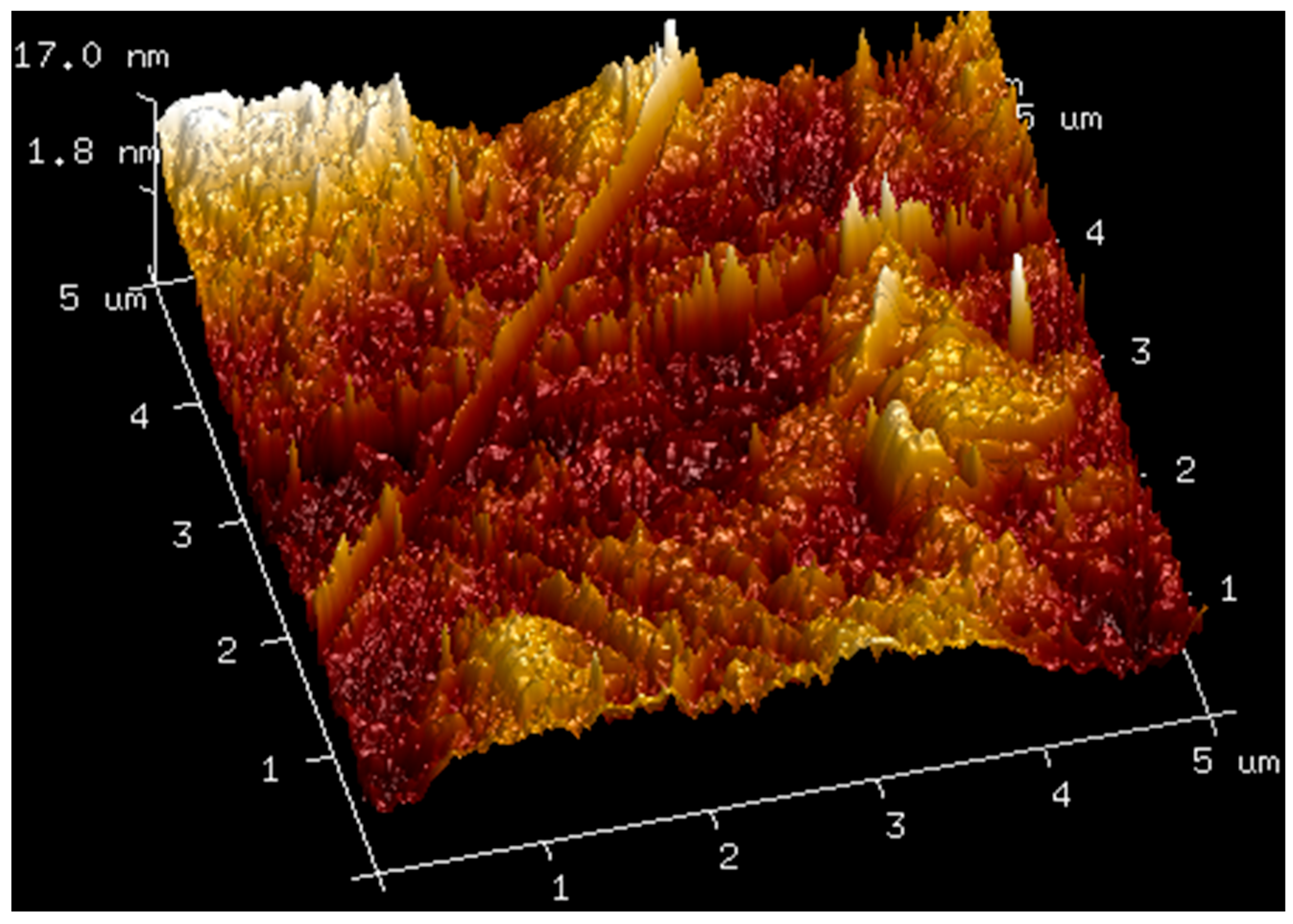
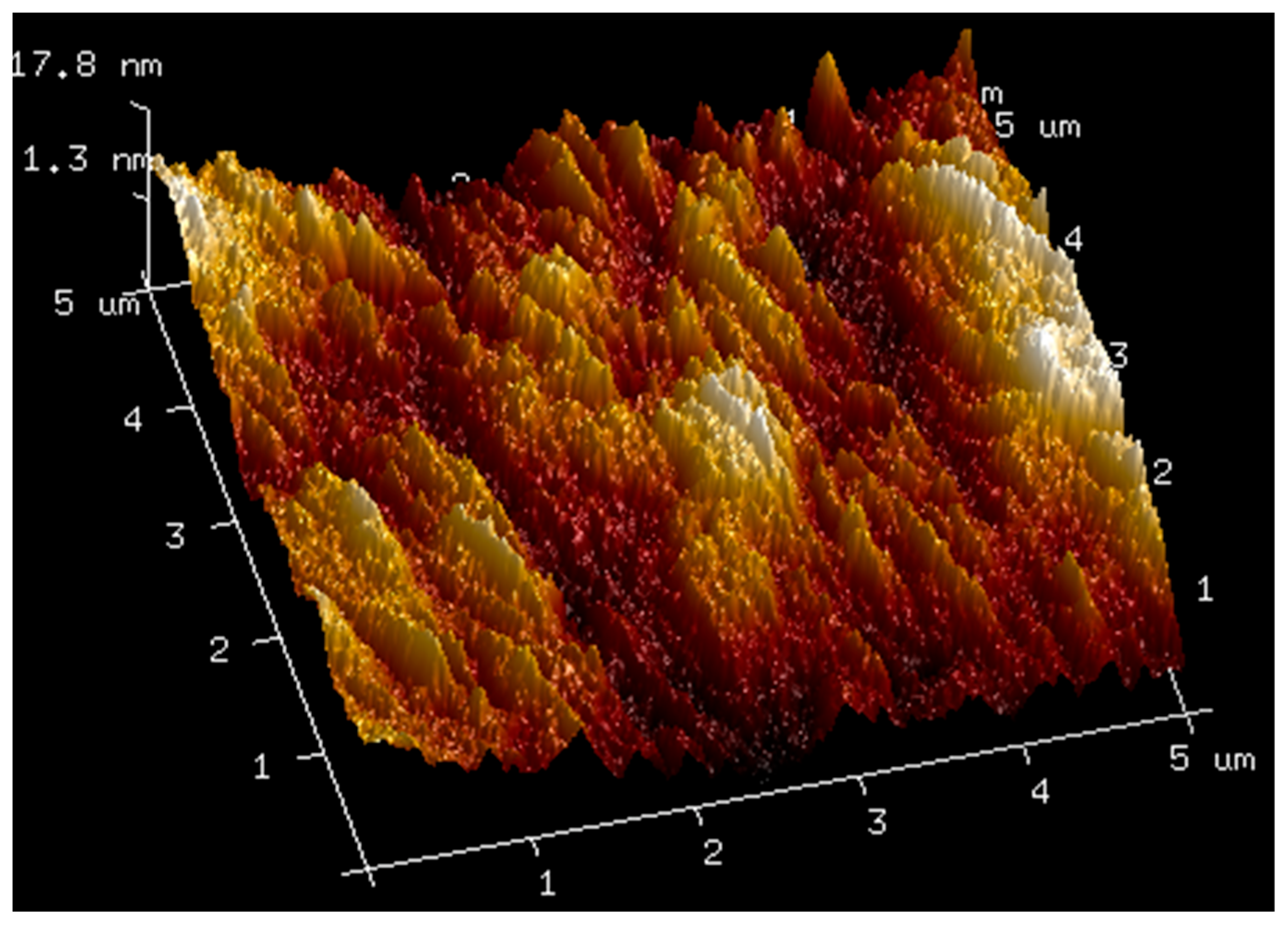

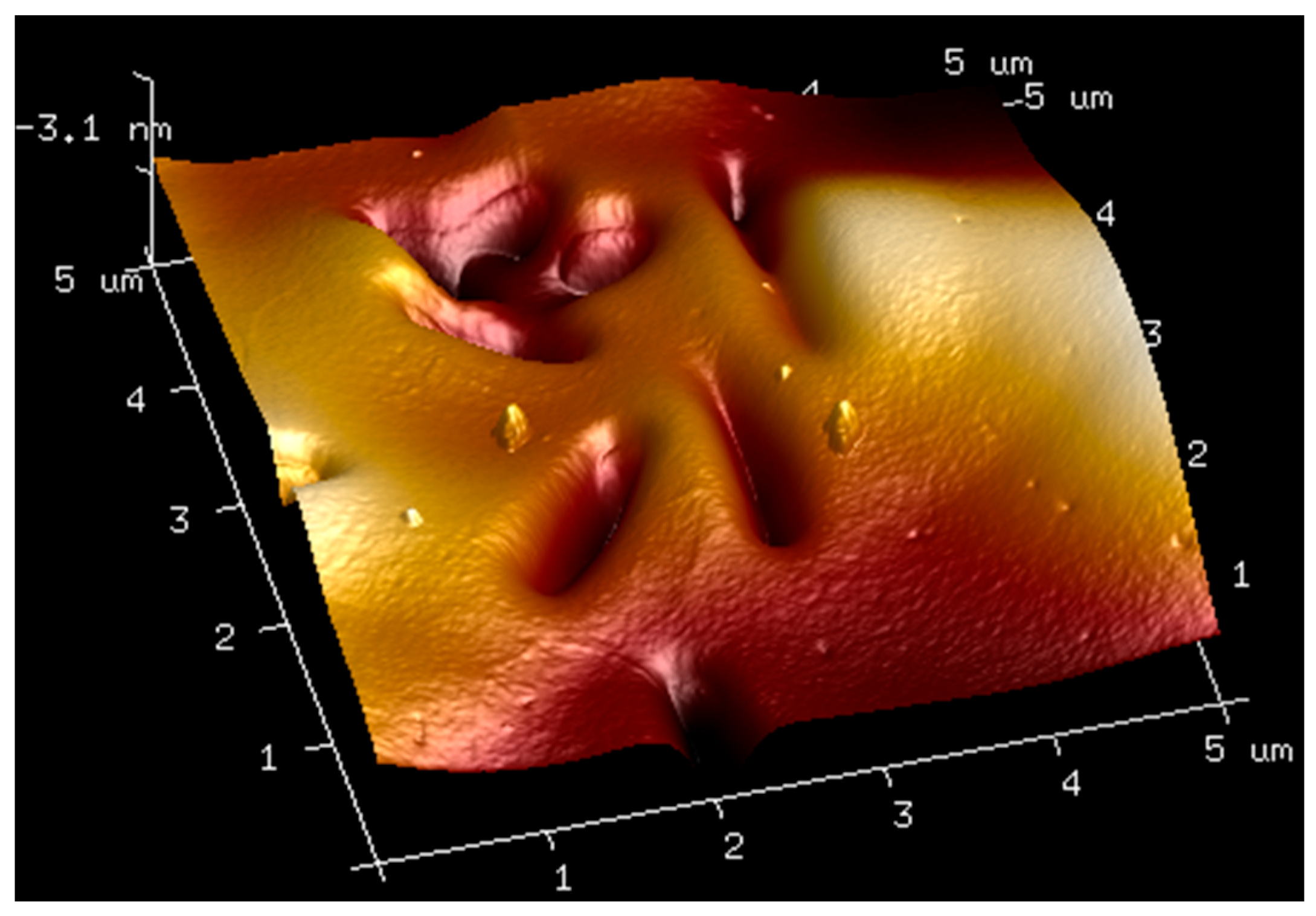

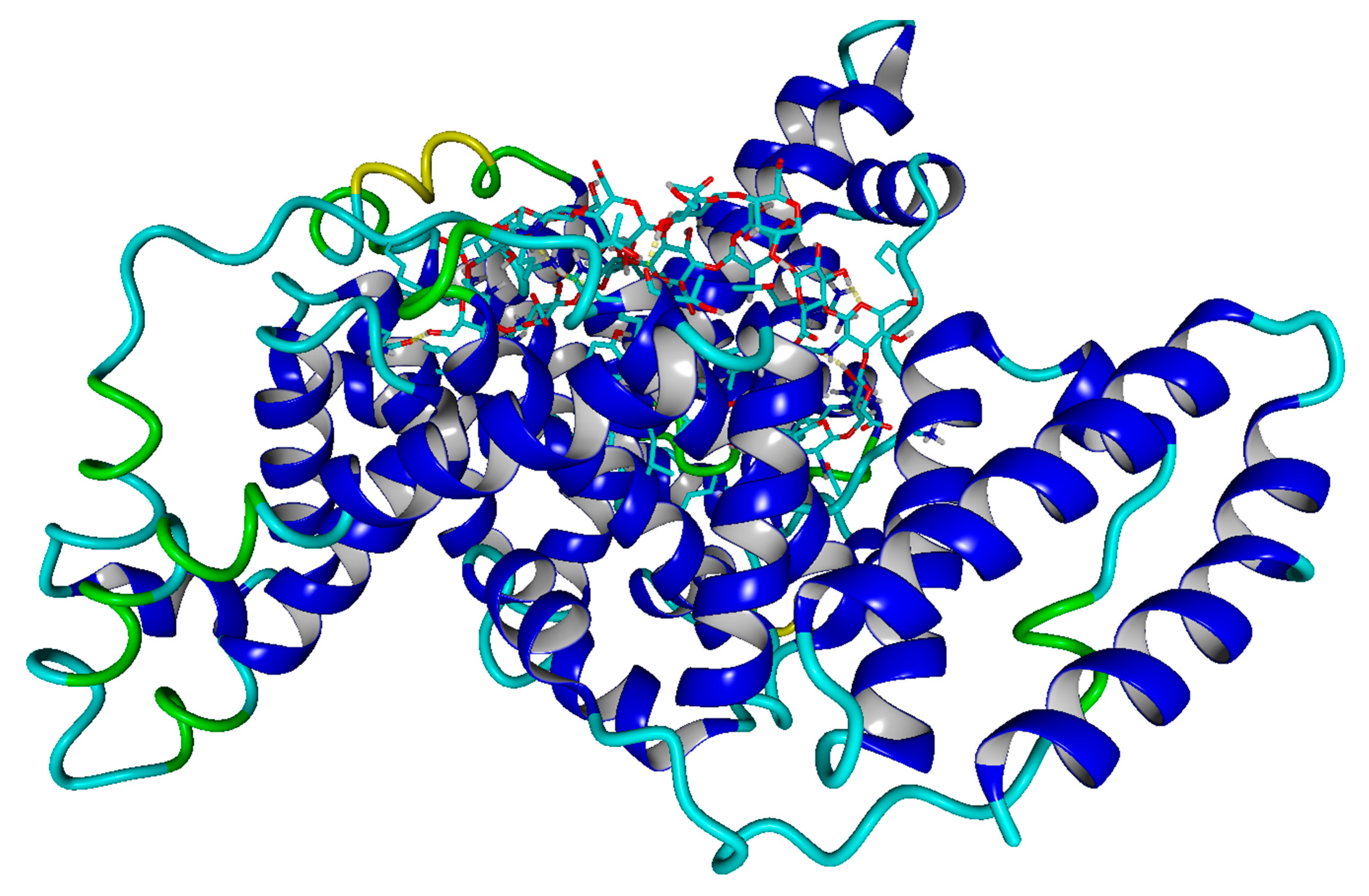
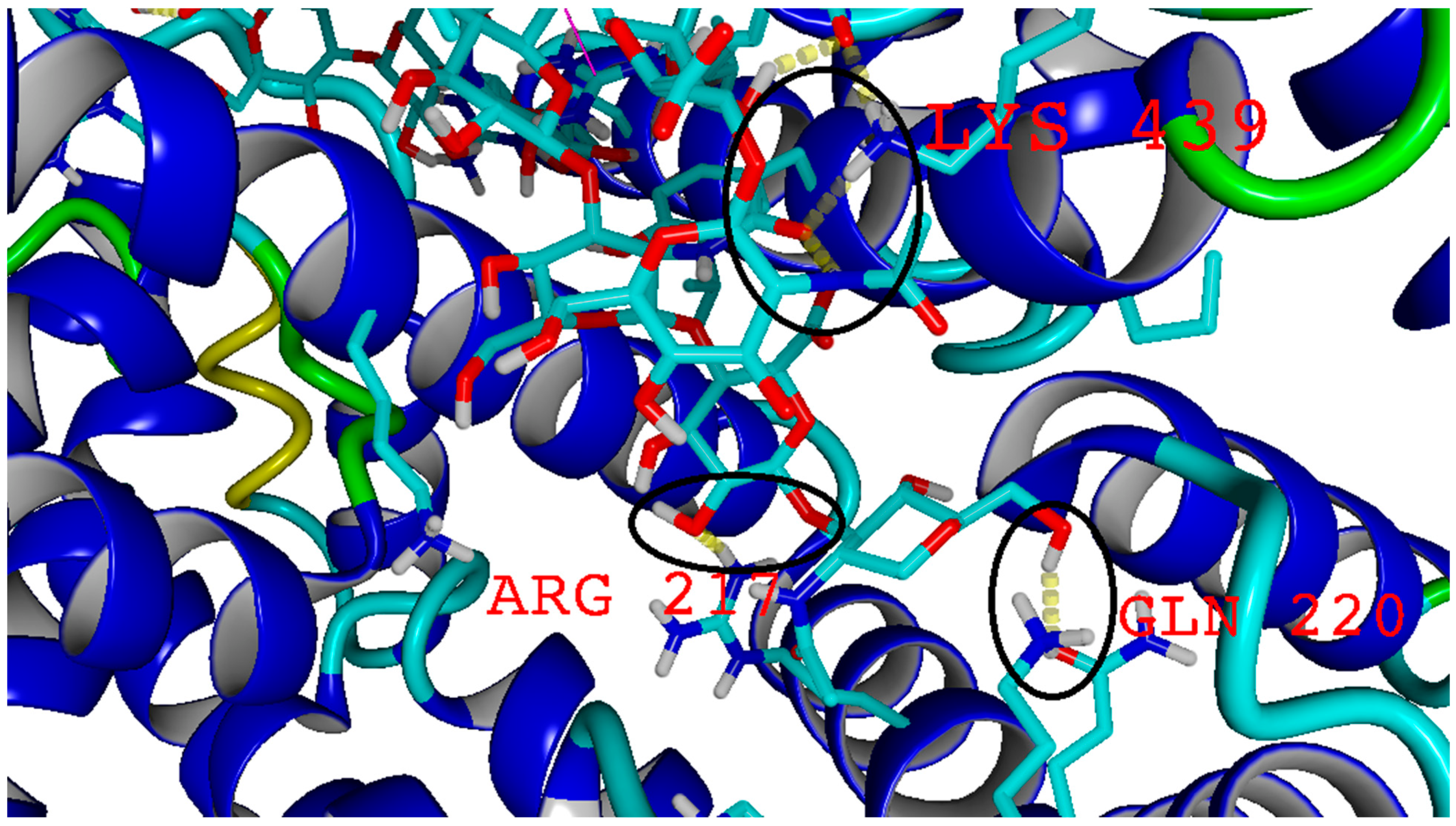
| Function Group | Vibrations | Bond Position for 1.5% High-Molecular HA [cm−1] | Band Position for 1.5% Low-Molecular HA [cm−1] | Band Position for 1.5% Ultralow-Molecular HA [cm−1] |
|---|---|---|---|---|
| O-H | Stretching | 3332 | 3291 | 3366 |
| C-H | Stretching | 2928 | 2927 | 2921 |
| N-H | Deformative | 1607 | 1607 | 1605 |
| C-N | Stretching | 1409 | 1409 | 1407 |
| COH | Stretching | 1038 | 1036 | 1036 |
| COC | Stretching | 609 | 608 | 607 |
| Function Group | Vibrations | Band Position for 1% BSA [cm−1] |
|---|---|---|
| O-H/Amide A | Stretching | 3290 |
| C-H | Stretching | 2959 |
| N-H | Deformative | 1650 |
| C-N | Stretching | 1541 |
| O-H | Stretching | 1395 |
| COC | Stretching | 622 |
| Function Group | Vibrations | Band Position for 1.5% High-Molecular HA with 1% BSA [cm−1] | Band Position for 1.5% Low-Molecular HA with 1% BSA [cm−1] | Band Position for 1.5% Ultralow-Molecular HA with 1% BSA [cm−1] |
|---|---|---|---|---|
| O-H/Amide A | Stretching | 3286 | 3285 | 3292 |
| C-H | Stretching | 2933 | 2928 | 2929 |
| N-H | Deformative | 1650 | 1650 | 1651 |
| C-N | Stretching | 1542 | 1542 | 1548 |
| O-H | Deformative | 1402 | 1399 | 1405 |
| COH | Stretching | 1034 | 1031 | 1041 |
| COC | Stretching | 607 | 554 | 608 |
| Sample | Young’s Modulus Emod [GPa] | Tensile Strength [MPa] | Elongation at Break [%] |
|---|---|---|---|
| 1.5% high-molecular HA | 0.733 ± 0.463 | 58.53 ± 6.24 | 9.57 ± 5.0 |
| 1.5% low-molecular HA | 0.21 ± 0.45 | 58.37 ± 1.19 | 16.13 ± 6.2 |
| 1.5% ultralow-molecular HA | 0.621 ± 0.351 | 48.07 ± 12.0 | 2.71 ± 0.5 |
| Sample | Young’s Modulus Emod [GPa] | Tensile Strength [MPa] | Elongation at Break [%] |
|---|---|---|---|
| 1.5% high-molecular HA with 1% BSA | 0.58 ± 0.331 | 54.18 ± 4.65 | 0.17 ± 0.9 |
| 1.5% low-molecular HA with 1% BSA | 0.55 ± 0.379 | 53.6 ± 5.86 | 4.33 ± 1.1 |
| Sample | Ra [nm] | Rq [nm] |
|---|---|---|
| 1.5% high-molecular-weight HA | 3.12 | 3.99 |
| 1.5% low-molecular-weight HA | 3.81 | 4.78 |
| 1.5% ultralow-molecular-weight HA | 3.87 | 5.21 |
| 1.5% high-molecular-weight HA with 1% BSA | 36.8 | 45.7 |
| 1.5% low-molecular-weight HA with 1% BSA | 51.8 | 65.1 |
Publisher’s Note: MDPI stays neutral with regard to jurisdictional claims in published maps and institutional affiliations. |
© 2022 by the authors. Licensee MDPI, Basel, Switzerland. This article is an open access article distributed under the terms and conditions of the Creative Commons Attribution (CC BY) license (https://creativecommons.org/licenses/by/4.0/).
Share and Cite
Gadomska, M.; Musiał, K.; Bełdowski, P.; Sionkowska, A. New Materials Based on Molecular Interaction between Hyaluronic Acid and Bovine Albumin. Molecules 2022, 27, 4956. https://doi.org/10.3390/molecules27154956
Gadomska M, Musiał K, Bełdowski P, Sionkowska A. New Materials Based on Molecular Interaction between Hyaluronic Acid and Bovine Albumin. Molecules. 2022; 27(15):4956. https://doi.org/10.3390/molecules27154956
Chicago/Turabian StyleGadomska, Magdalena, Katarzyna Musiał, Piotr Bełdowski, and Alina Sionkowska. 2022. "New Materials Based on Molecular Interaction between Hyaluronic Acid and Bovine Albumin" Molecules 27, no. 15: 4956. https://doi.org/10.3390/molecules27154956
APA StyleGadomska, M., Musiał, K., Bełdowski, P., & Sionkowska, A. (2022). New Materials Based on Molecular Interaction between Hyaluronic Acid and Bovine Albumin. Molecules, 27(15), 4956. https://doi.org/10.3390/molecules27154956







